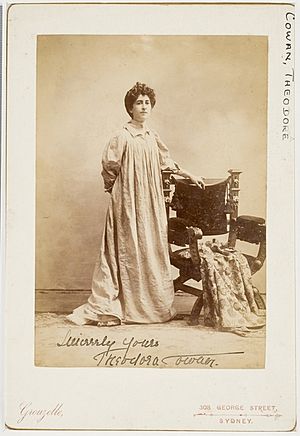Theodora Cowan facts for kids
Quick facts for kids
Theodora Esther Cowan
|
|
|---|---|

Cowan c.1898
|
|
| Born | 13 November 1868 Sydney, New South Wales, Australia
|
| Died | 27 August 1949 (aged 80) Vaucluse, New South Wales, Australia
|
| Education |
|
| Known for | Sculpture, painting |
Theodora Esther Cowan (Theo) (1868–1949) was an important Australian artist. She is known as the first woman born in Australia to become a sculptor. Theo Cowan was one of many talented women sculptors working in the late 1800s. She was among the first to become very successful, especially with her portrait sculptures.
Contents
Theo Cowan's Life Story
Theo Cowan was born in Sydney, Australia, in 1868. She started learning art at the Sydney Technical College. In 1889, she moved to Italy with her family. She stayed there for six years.
Studying Art in Italy
In Italy, Theo studied at the Academy of Fine Arts in Florence. She learned from famous teachers like Longworth Powers and Augusto Rivalta. This is where she learned the skills for her art. Many young Australian sculptors, like Bertram Mackennal, also went to Europe to study art around this time.
While in Italy, Theo met many important people. These included the composer Pietro Mascagni and the American sculptor Harriet Hosmer.
Returning to Australia and London
In 1895, Theo Cowan came back to Sydney. She opened her own art studio. She found that some people had unfair ideas about women sculptors. She felt like a "pioneer" because she was doing something new for women.
In 1901, Theo traveled to London, England. She set up another studio there. She met famous artists, including William Holman Hunt. Theo returned to Sydney again in 1913 and continued her work. She had good friends in Australia, like the Governor, Lord Hampden, and the Prime Minister, George Reid. They supported her work as a woman artist.
In 1902, Theo Cowan was featured in an article called "Notable Australian Women." This article also included other famous women like Nellie Melba. Theo Cowan passed away in Sydney in 1949.
Theo Cowan's Art Career
Theo Cowan's first big art job was in Italy. She created a monument for Miss Pearson, a Red Cross nurse. This monument was placed in a cemetery in Italy.
Working on Important Projects
Theo was asked to create a small model for sculptures on the Queen Victoria Building in Sydney. Her design showed three female figures, but it was not chosen. Another artist got the job.
She was a finalist for the Wynne Prize in 1897 and again in 1925. After returning to Sydney in 1913, Theo received many jobs. She created art for the New South Wales Government and other groups. She made a small sculpture of Dr. Hinder for a hospital.
Involvement in Art Societies
In Sydney, Theo often showed her art at the Society of Artists. She was even a member of their Council for a time. She was also active in the Society of Women Painters. Later in her life, Theo became more interested in watercolour painting and did less sculpture.
Famous Works by Theo Cowan
Theo Cowan created many portrait sculptures of important people. A portrait bust is a sculpture that shows only the head and shoulders of a person.
Notable Portrait Busts
One of her most famous works was a portrait bust of the Bishop of London, Arthur Winnington-Ingram. This sculpture was shown at her solo exhibition in London.
Other well-known people she sculpted included:
- Sir Gilbert Parker
- Sir Edmund Barton, who was Australia's first Prime Minister
- Sir Henry Parkes
- A full-length small statue of Mrs. Brown-Potter
Her art can be seen in important places like the Art Gallery of New South Wales and Parliament House, Canberra.
Challenges and Recognition
Theo's sculpture of Eccleston du Faur was the first time the Art Gallery of New South Wales asked a Sydney artist to create a work. After it was finished, some people in Parliament questioned why a woman was given the job. This shows the challenges she faced.
Her portrait bust of Eliezer Levi Montefiore, created in 1898, shows how skilled she was at making portraits. In 1902, she was asked to sculpt a marble bust of the famous Egyptologist Flinders Petrie.
Awards and Exhibitions
Theo Cowan received several awards for her artistic talent.
- 1899: She won an award at the Society of Artists' Spring Exhibition for her sculpture of Sir Edmund Barton.
- 1900: She held a very successful solo art show at the Grafton Gallery in London.
- 1907: She won First Prize at the London Exhibition of Work by Women Artists.
- 1908: She won a gold medal at the Franco-British Exhibition for her sculpture Will-o-the-Wisp. This was recognized as the best child portrait sculpture.

